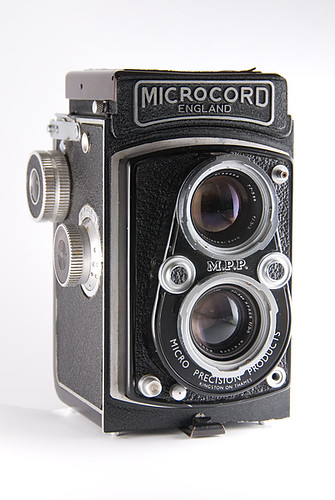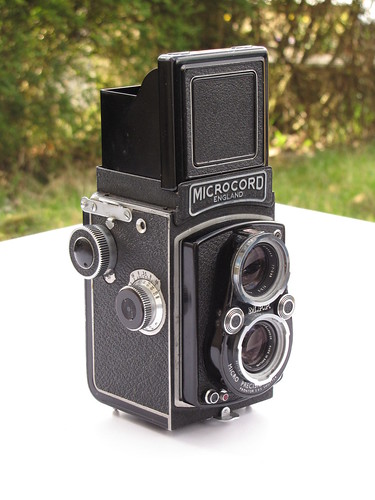Microcord

Microcord Mk. I
Image by John Hughes (Image rights)
The Microcord is a knob-wound 6×6 TLR made by Micro Precision Products, manufactured from 1951 to 1958. This was a major innovation for MPP; all its earlier cameras had been large-format.[1]
The Microcord Mk I[2] was manufactured in 1951 but its release was held back for the British Industries Fair of 1952. Its design was based on that of the Rolleicord; A J Dell, then in charge of photographic products for MPP (and later the company head) had acquired a Rolleicord and taken it to pieces in order to learn from and improve upon it.[1] The camera has a pair of 77.5mm f/3.5 Ross Xpres lenses, made by Ross to MPP's design and assembled and collimated by MPP. The taking lens has four elements, the viewing lens three. The Microcord has an eight-speed Epsilon shutter, complete with a "T" setting.[1]
Film advance uses a red window. The Microcord Mk I (and not the Mk II) has "a focusing hood incorporating a special reflector to enable eye level viewing".[1]
The 12 November 1952 issue of the British magazine Amateur Photographer concluded its tests of the camera with the comment that "the Microcord's standard of performance is as high if not higher than any camera of this negative size that we have yet handled."[3]
Microcord Mk II
Image by Born in York (Image rights)
The Microcord Mk II was introduced in 1954. The major change is that to a Prontor SVS shutter, with DXM settings. (This shutter lacks "T".) Film winding is semi-automated and there is no red window. The hood has a pop-up mirror for careful focussing, and also can be converted to "direct vision" (see through), for sports, etc.[1]
The very earliest examples of the Microcord Mk II have the film counter return to zero when the back is opened. As this design infringed a patent of Franke and Heidecke, MPP had to change this to a design in which the counter returned to zero when the back was closed; it recalled the earliest cameras for this design change, although rare examples may remain unconverted.[1]
MPP provided a service to convert customers' examples of the Mk I to have the new Prontor shutter, and also did other conversions, e.g. from the vulnerable external flash connections of the Mk I to the sunken connections of the Mk II. Because of this, and because only the later examples of the Mk II have the escutcheon under the taking lens marked for the shutter rather than with "Kingston on Thames" (the place of manufacture, as marked on all unaltered examples of the Mk I), the mistaken rumour has arisen that there exists a "Mk 1½".[1]
The film counter mechanism is the most troublesome aspect of surviving examples of the Microcord.[1]
In 1958 MPP replaced the Microcord Mk II with the Microflex.
Notes
- ↑ 1.0 1.1 1.2 1.3 1.4 1.5 1.6 1.7 Basil Skinner, "The MPP Twin Lens Reflex", pp. 47–52 of Micro Precision Products: The MPP Story and the Products (Newquay, Cornwall: MPP Publications; ISBN 0-9546070-1-5).
- ↑ Both versions of the Microcord are themselves simply marked MICROCORD ENGLAND, with no hint of a version number. It is extremely unlikely that MPP would ever have referred to "Mk I", at least until the appearance of the "Mk II". Even the box for the Mk II — or at least the example that Skinner shows (p.49) — is simply marked "Microcord", with no mention of "Mk II" or similar. Skinner seems to use "Microcord Mk I", "Microcord Model I" (and "Microcord model I"), and "Microcord I" interchangeably; and also seems to use the analogous forms for its successor interchangeably. One publicity item that he reproduces (p.51) does use "Mk II".
- ↑ As quoted by Skinner, p.48.
Links
- MPP TLRs (archived) at the MPP Users' Club
- Discussion of MPP TLRs at Photo.net
- Microcord Mk II at Nigan Riteihyō (二眼里程標, i.e. "TLR Milestones"). In Japanese, but well photographed.
- Microcord Mk II at J R Ong's Artemis Works Gallery
- Microcord I and II Guide, PDF at Butkus' OrphanCameras.com
- Microcord MK II PDF manual at Butkus' OrphanCameras.com
